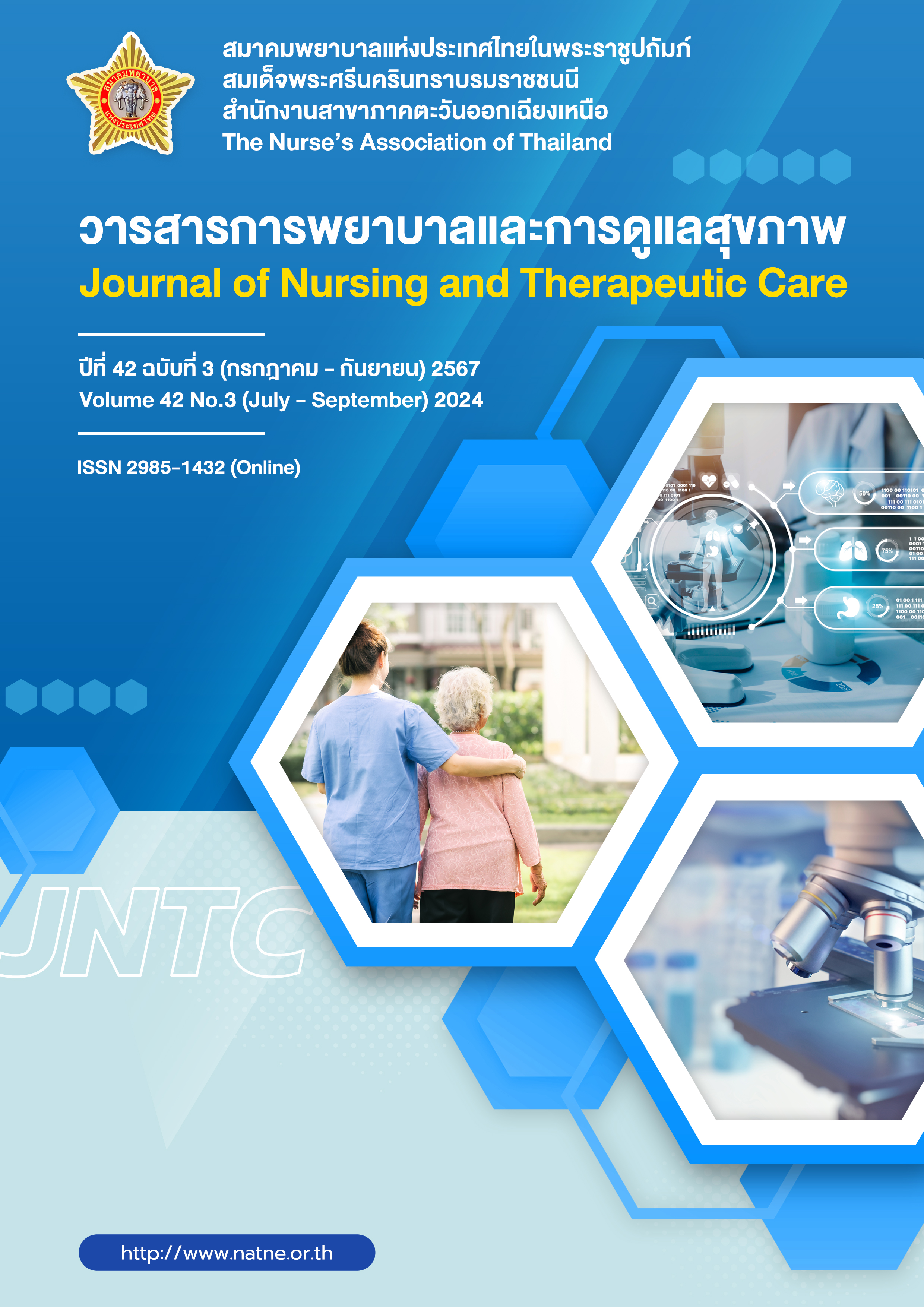ผลของการดูแลผู้ป่วยประคับประคองในวาระสุดท้ายที่บ้านต่อผลลัพธ์การดูแล และภาระของญาติ : โรงพยาบาลระดับเหนือตติยภูมิ
คำสำคัญ:
การดูแลผู้ป่วยที่บ้าน, ภาระการดูแล, ผลลัพธ์การดูแลแบบประคับประคอง, ระยะท้ายใกล้เสียชีวิตบทคัดย่อ
การวิจัยกึ่งทดลองครั้งนี้มีวัตถุประสงค์เพื่อศึกษาผลของรูปแบบการดูแลผู้ป่วยระยะท้ายที่บ้านต่อผลลัพธ์การดูแลผู้ป่วยแบบประคับประคองโดยเฉพาะ การบรรเทาความทุกข์ทรมานทางร่างกาย จิตสังคม และจิตวิญญาณ รวมถึงการให้ข้อมูลและภาระการดูแลของญาติผู้ดูแล ศูนย์การุณรักษ์ โรงพยาบาลศรีนครินทร์ คัดเลือกกลุ่มตัวอย่างแบบเฉพาะเจาะจงตามเกณฑ์ที่กำหนด จำนวน 32 ราย รูปแบบการดูแลประกอบด้วยการเยี่ยมบ้าน การติดตามโทรเวชกรรมทุกวัน ระบบให้คำปรึกษา 24 ชั่วโมง และคู่มือบันทึกสุขภาพที่บ้าน ดูแลต่อเนื่องจนกว่าผู้ป่วยเสียชีวิต เก็บข้อมูลโดยใช้แบบประเมินผลลัพธ์การดูแลผู้ป่วยแบบประคับประคอง ฉบับใช้ถามผู้ดูแลของผู้ป่วยและแบบประเมินภาระการดูแลผู้ป่วยที่บ้าน Zarit Burden ก่อนและหลังการเข้าร่วมวันที่ 3 และวันที่ 7 ดูแลต่อเนื่องจนกว่าผู้ป่วยเสียชีวิต วิเคราะห์ข้อมูลโดย การแจกแจงความถี่ ค่าร้อยละ ค่าเฉลี่ยและส่วนเบี่ยงเบนมาตรฐาน เปรียบเทียบค่าคะแนนเฉลี่ยด้วยสถิติ Generalized linear models และMultiple comparison
ผลการวิจัยพบว่า ภายหลังการใช้รูปแบบการดูแล ค่าคะแนนเฉลี่ยข้อมูลผลลัพธ์การดูแลผู้ป่วยแบบประคับประคองน้อยกว่าก่อนทดลองในวันที่ 3 และวันที่ 7 แตกต่างอย่างมีนัยสำคัญทางสถิติที่ระดับ .05 และค่าคะแนนเฉลี่ยภาระการดูแลน้อยกว่าก่อนทดลองในวันที่ 7 แตกต่างอย่างมีนัยสำคัญทางสถิติที่ระดับ .05 ดังนั้น รูปแบบการดูแลผู้ป่วยประคับประคองในวาระสุดท้ายที่บ้านมีผลลัพธ์การดูแลที่ดี ช่วยให้ผู้ป่วยมีอาการทุกข์ทรมานทางร่างกาย จิตสังคมน้อยลง ญาติผู้ดูแลได้รับข้อมูลที่ดีขึ้นและมีคุณภาพการดูแลที่ดีขึ้นกว่าเดิม ทำให้ภาระการดูแลของญาติผู้ดูแลลดลง
Downloads
เอกสารอ้างอิง
World Health Organization. Palliative care [Internet]. 2022 [cited 2024 May 5]. Available from: https://www.who.int/health-topics/palliative-care
Piasupun P. Home-based palliative care. In: Dusit S, Laksamee C, editors. The dawn of palliative care in Thailand. Bangkok: Beyond Enterprise Co., Ltd.; 2013. PP.77-90. (in Thai)
Juntaboon W, Promphakping B. Wellbeing and care system for palliative care in a community. Srinakharinwirot Research and Development Journal of Humanities and Social Sciences. 2021;14(2):151-65. (in Thai)
Hui D, Dev R, Bruera E. The last days of life: symptom burden and impact on nutrition and hydration in cancer patients. Curr Opin Support Palliat Care. 2015;9(4):346-54.
Kuusisto A, Saranto K, Korhonen P, Haavisto E. Social and healthcare professionals’ experiences of end-of-life care planning and documentation in palliative care. Nurs Open. 2023;10(9):6445–54.
Puangkam A, Suwansri D, Yamsri T, Saengrueang-eak M, Towannans R. The impact of patients and caregivers: relevant factors and needs of relatives who care for chronic end-stage illnesses at home. Medical Journal of Srisaket Surin Buriram Hospitals. 2020;35(2):303-16. (in Thai)
Ko HJ, Seo SJ, Youn CH, Kim HM, Chung SE. The association between pain and depression, anxiety, and cognitive function among advanced cancer patients in the hospice ward. Korean J Fam Med. 2013;34(5):347-56.
Uengsook W, Kanthawee P, Markmee P. Factors associated with quality of life among cancer patients with palliative care at the end of life residing in Chiang Rai province. Nursing Journal of The Ministry of Public Health. 2019;29(2):116-28. (in Thai)
Hudson PL, Thomas K, Trauer T, Remedios C, Clarke D. Psychological and social profile of family caregivers on commencement of palliative care. J Pain Symptom Manage. 2011;41(3):522-34.
Karunruk Palliative Care Excellence Center, Srinagarind Hospital. Patient statistics for the years 2018-2021. Khon Kaen: Faculty of Medicine, Khon Kaen University; 2022. (In Thai)
Sribunlue P, Pirojkul S, Piasupan P, Bualakorn N. Outcomes of symptom management among patients receiving in-home visit of palliative telemedicine system during the COVID-19 pandemic. Srinagarind Medical Journal. 2021;37(1):76-81.
Likhitluecha N. Nursing care for home ward patients. Bangkok: Nursing Division, Ministry of Public Health; 2013. (In Thai)
Ruland CM, Moore SM. Theory construction based on standards of care: a proposed theory of the peaceful end of life. Nurs Outlook. 1998;46(4):169-75.
Boonariyatep T, Intharawut T. The effect of home palliative care program on patients' symptom-induced suffering, care outcome and caregivers' stress. Journal of the Phrae Hospital. 2023;31(1):99-103. (in Thai)
Sapinun L. Manual for using the palliative care outcome scale: POS. 1st ed. Chiang Mai: Kwangwien Printing; 2013. (in Thai)
Karunruk Palliative Care Center, Srinagarind Hospital, Faculty of medicine, Khon Kaen University. Palliative care toolkit. 1st ed. Khon Kaen: Klungnana; 2017. (in Thai)
Prasartkul P. Situation of the Thai elderly 2017. Bangkok: Foundation of Thai Gerontology Research and Development Institute; 2017. (in Thai)
Guerriere D, Husain A, Zagorski B, Marshall D, Seow H, Brazil K, et al. Predictors of caregiver burden across the home-based palliative care trajectory in Ontario, Canada. Health Soc Care Community. 2016;24:428-38
Meecharoen W. Relatives caring for cancer patients: role adjustment and quality of life promotion. Nursing Research and Innovation Journal. 2014;20(1):10-22. (in Thai)
Brumley RD, Enguidanos S, Cherin DA. Effectiveness of a home-based palliative care program for end-of-life. J Palliat Med. 2004;6(5):715-24.
Soroka J, Froggatt K, Morris S. Family caregivers’ confidence caring for relatives in hospice care at home: an exploratory qualitative study. Am J Hosp Palliat Care. 2018;35:1540-6.
Areia N, Fonseca G, Major S, Relvas A. Psychological morbidity in family caregivers of people living with terminal cancer: prevalence and predictors. Palliat Support Care. 2019;17:286-93.
Krug K, Miksch A, Peters-Klimm F, Engeser P, Szecsenyi J. Correlation between patient quality of life in palliative care and burden of their family caregivers: a prospective observational cohort study. BMC Palliat Care. 2016;15:4-10.
House JS, Umberson D, Landis KR. Structure and processes of social support. Annu Rev Sociol. 1988;14:293-318.
ดาวน์โหลด
เผยแพร่แล้ว
รูปแบบการอ้างอิง
ฉบับ
ประเภทบทความ
สัญญาอนุญาต
ลิขสิทธิ์ (c) 2024 วารสารการพยาบาลและการดูแลสุขภาพ

อนุญาตภายใต้เงื่อนไข Creative Commons Attribution-NonCommercial-NoDerivatives 4.0 International License.



